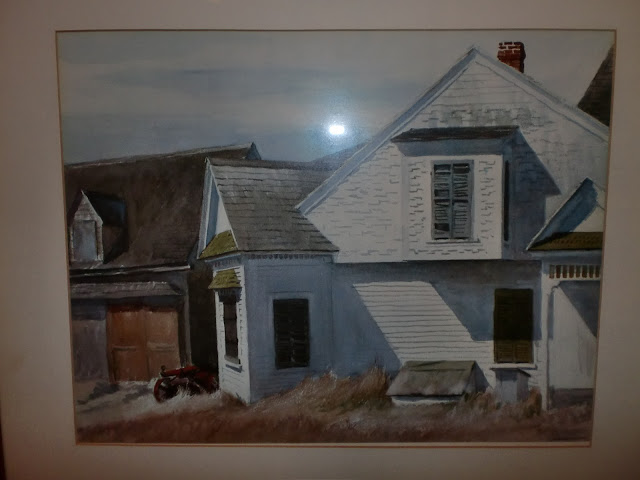 |
| Purchased on December 21, 2012 |
 |
| House on Pamet River 1934 |
This is a framed art print by Edward Hopper which was painted in 1934 titled 'House on Pamet River'.
The original artwork is in Whitney Museum of American Art, New York.
In 1930, Edward Hopper and his wife, Josephine Hopper, decided to spend their summer in South Truro, MA. Hopper described the landscape of this isolated town near the tip of Cape Cod as composed of “fine big hills of sand — a very open almost treeless country.” The area’s wind-swept dunes and solitary houses provided a fresh source of inspiration for him that made his first summers there were among the most productive he had known.
In 1933, when Jo Hopper inherited some money, they bought a land and built a house in South Truro; the couple spent nearly every summer and early fall there for the rest of their lives. Although their house had breathtaking views of Cape Cod Bay, the artist never painted these vistas. As in Gloucester and Maine, he was not interested in producing such typical views. Instead, he often depicted one house standing alone in nature, conveying the remoteness and quiet of the sparsely populated area around Truro. During this time, Hopper began to create more monumental watercolors, using thicker and larger paper. He also simplified the area’s austere houses to emphasize their abstraction and, as in House on Pamet River, compressed the pictorial space.
As Scene painting dominated American art at that time period, artists were turned away from European-influenced abstraction toward more realistic depictions of specifically American places and regions. Hopper felt strongly that American Scene paintings caricatured American culture, and he rejected the attempt to create a national art. Painting for Hopper was an intensely personal act that “My aim in painting, has always been the most exact transcription possible of my most intimate impressions of nature.”
 |
| Edward Hopper (1882 - 1967) |
Edward Hopper (1882 – 1967) produced some of the most enduringly popular images in American art. Throughout his career, he created quiet yet riveting pictures that express both sense of isolation and uncertainty and the bittersweet comfort of solitude. His images of apartments, diners, and movie palaces reflect American urban life between the world wars, while his light-filled watercolors of New England evoke that region’s austere beauty.
Born in Nyack, New York, along the Hudson River, Hopper did not come to artistic maturity until the mid-1920s - an age whose celebrated prosperity, enjoyed by the few, gave way to the Depression. Avoiding direct social commentary, his work reflects the contemporary interest in ordinary people and unexceptional places—subjects that in his hands became both evocative and insightful. The tall and taciturn artist painted images that have been described as spare, disciplined, honest, and even puritanical. Working slowly and deliberately, he pared scenes down to the essentials. While his paintings seem empty and silent, they are filled with an underlying tension, so that the slightest action—a gently rustling curtain or a piano key struck absently—takes on a mysterious significance.
Hopper's vision was unique. The people inhabiting his city and suburban scenes are lonely, anonymous, temporary inhabitants of sometimes inhospitable environments. When there is no human element, he transfers these qualities to the architecture or even to the landscape itself, using intense light to infuse human emotion.
Although the artist received many honors in his lifetime. Hopper himself made no great claims for his art. “What I wanted to do,” he said, “was to paint sunlight on the side of a house.”
There is a frugality in Hopper's work, a careful selection of people, buildings and interiors, just as there was to the man himself. He worked in the same studio on Washington Square for 54 years, rarely venturing out except for summers in New England and an occasional visit to the Southwest. He died in his studio on May l5, l967.
Edward Hopper is represented in every major institution in the US.
 |
| South Truro, MA - Cape Cod |
Art Print, originally watercolor
Image size: 12.5 x 18 in.
Frame size: 18 x 21.5 in.
Artist Biography:
http://www.askart.com/AskART/H/edward_hopper/edward_hopper.aspx
http://www.artic.edu/aic/collections/exhibitions/hopper/capecod
References:
http://en.wikipedia.org/wiki/Edward_Hopper
http://en.wikipedia.org/wiki/Josephine_Hopper

No comments:
Post a Comment